 Operation and Maintenance
Operation and Maintenance
 Linux Operation and Maintenance
Linux Operation and Maintenance
 What is the command to run sql file in linux
What is the command to run sql file in linux
What is the command to run sql file in linux
The command to run a sql file on Linux is "psql -f test.sql". The method for running a sql script on Linux is: 1. Use the shell tool to log in to the server where postgresql is installed; 2. Edit the content of the sql script; 3. . Execute the "test.sql" script through the "psql -f test.sql" command.

#The operating environment of this tutorial: linux5.9.8 system, Dell G3 computer.
What is the command to run sql file on Linux?
The specific steps for running sql scripts on Linux are as follows:
1. Use the shell tool to log in to the server where postgresql is installed, switch to the postgres user, the default operating user of postgresql, the command is :su - postgres, check that the current path is /var/lib/psql, create a test.sql script file, the command is: vim test.sql.
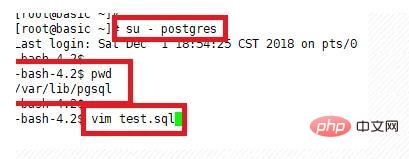
2. The content of the sql script is: create table test (id int not null primary key,name text);insert into test valus(1, 't1');

3. Execute the test.sql script, the command is: psql -f test.sql
This is because postgresql is installed on this machine, in the first step We switched to the postgres user, so the default is the postgres user to operate here, without bringing the user name and password. The execution results are as follows. You can see two prompts:
create table
insert 0 1
After the execution is completed, we log in to the database and the command is: psql

4. After entering the psql interactive command line, we execute two view commands:\d
You can see that the table test has indeed been created successfully, and then execute the command: \d test
You can see that the fields in the table are id and name, which are the same as the content in our creation statement, indicating that the first statement was executed successfully.
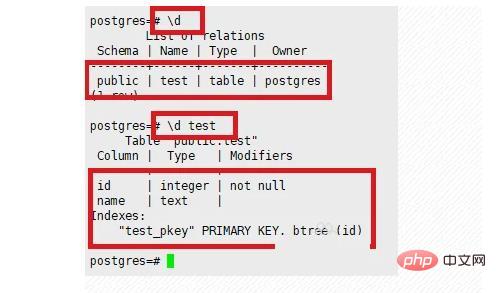
5. Check the data in the table. The command is: select * from test;
The displayed value is 1, t1, indicating that the second item is executed. The statement is also executed successfully, indicating that the test.sql script is executed successfully.
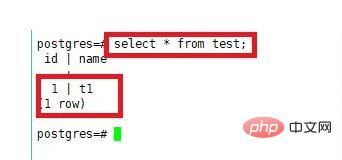
6. The default is postgres user. The local operation is, no user and password are required. Now let’s try to operate postgresql on the remote linux server, that is to say, execute A local script file that creates the table on the remote server. As shown in the figure below, the command is: psql -U test1 -h 192.168.1.194 -f test.sql, enter the password of the corresponding user.
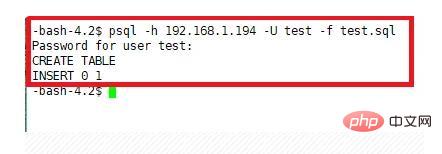
7. Log in to this remote server. The command is: psql -U test -h 192.168.194
Execute the view command: \d,\ d test
Finally query the database: select * from test; the results are consistent with the above.
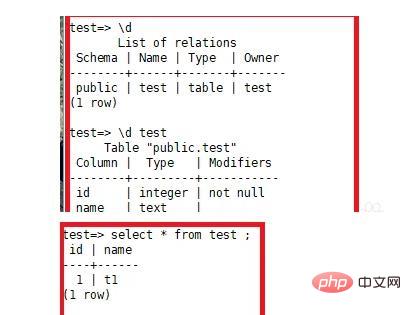
Recommended study: "Linux Video Tutorial"
The above is the detailed content of What is the command to run sql file in linux. For more information, please follow other related articles on the PHP Chinese website!

Hot AI Tools

Undresser.AI Undress
AI-powered app for creating realistic nude photos

AI Clothes Remover
Online AI tool for removing clothes from photos.

Undress AI Tool
Undress images for free

Clothoff.io
AI clothes remover

Video Face Swap
Swap faces in any video effortlessly with our completely free AI face swap tool!

Hot Article

Hot Tools

Notepad++7.3.1
Easy-to-use and free code editor

SublimeText3 Chinese version
Chinese version, very easy to use

Zend Studio 13.0.1
Powerful PHP integrated development environment

Dreamweaver CS6
Visual web development tools

SublimeText3 Mac version
God-level code editing software (SublimeText3)

Hot Topics
 What computer configuration is required for vscode
Apr 15, 2025 pm 09:48 PM
What computer configuration is required for vscode
Apr 15, 2025 pm 09:48 PM
VS Code system requirements: Operating system: Windows 10 and above, macOS 10.12 and above, Linux distribution processor: minimum 1.6 GHz, recommended 2.0 GHz and above memory: minimum 512 MB, recommended 4 GB and above storage space: minimum 250 MB, recommended 1 GB and above other requirements: stable network connection, Xorg/Wayland (Linux)
 Linux Architecture: Unveiling the 5 Basic Components
Apr 20, 2025 am 12:04 AM
Linux Architecture: Unveiling the 5 Basic Components
Apr 20, 2025 am 12:04 AM
The five basic components of the Linux system are: 1. Kernel, 2. System library, 3. System utilities, 4. Graphical user interface, 5. Applications. The kernel manages hardware resources, the system library provides precompiled functions, system utilities are used for system management, the GUI provides visual interaction, and applications use these components to implement functions.
 How to run java code in notepad
Apr 16, 2025 pm 07:39 PM
How to run java code in notepad
Apr 16, 2025 pm 07:39 PM
Although Notepad cannot run Java code directly, it can be achieved by using other tools: using the command line compiler (javac) to generate a bytecode file (filename.class). Use the Java interpreter (java) to interpret bytecode, execute the code, and output the result.
 How to check the warehouse address of git
Apr 17, 2025 pm 01:54 PM
How to check the warehouse address of git
Apr 17, 2025 pm 01:54 PM
To view the Git repository address, perform the following steps: 1. Open the command line and navigate to the repository directory; 2. Run the "git remote -v" command; 3. View the repository name in the output and its corresponding address.
 Can vscode be used for mac
Apr 15, 2025 pm 07:36 PM
Can vscode be used for mac
Apr 15, 2025 pm 07:36 PM
VS Code is available on Mac. It has powerful extensions, Git integration, terminal and debugger, and also offers a wealth of setup options. However, for particularly large projects or highly professional development, VS Code may have performance or functional limitations.
 How to use VSCode
Apr 15, 2025 pm 11:21 PM
How to use VSCode
Apr 15, 2025 pm 11:21 PM
Visual Studio Code (VSCode) is a cross-platform, open source and free code editor developed by Microsoft. It is known for its lightweight, scalability and support for a wide range of programming languages. To install VSCode, please visit the official website to download and run the installer. When using VSCode, you can create new projects, edit code, debug code, navigate projects, expand VSCode, and manage settings. VSCode is available for Windows, macOS, and Linux, supports multiple programming languages and provides various extensions through Marketplace. Its advantages include lightweight, scalability, extensive language support, rich features and version
 Where to write code in vscode
Apr 15, 2025 pm 09:54 PM
Where to write code in vscode
Apr 15, 2025 pm 09:54 PM
Writing code in Visual Studio Code (VSCode) is simple and easy to use. Just install VSCode, create a project, select a language, create a file, write code, save and run it. The advantages of VSCode include cross-platform, free and open source, powerful features, rich extensions, and lightweight and fast.
 vscode terminal usage tutorial
Apr 15, 2025 pm 10:09 PM
vscode terminal usage tutorial
Apr 15, 2025 pm 10:09 PM
vscode built-in terminal is a development tool that allows running commands and scripts within the editor to simplify the development process. How to use vscode terminal: Open the terminal with the shortcut key (Ctrl/Cmd). Enter a command or run the script. Use hotkeys (such as Ctrl L to clear the terminal). Change the working directory (such as the cd command). Advanced features include debug mode, automatic code snippet completion, and interactive command history.





